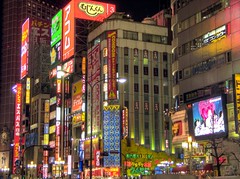When QTVR came out in the mid 90’s I was really into it. I took many cylindrical panoramas in my free time and also for clients of the web development company I worked for at the time. The technology has changed only a little since then, but the big advancement is that it’s now possible to see not only 360 degrees horizontally, but also vertically as well. I want to acquire the equipment, software and know-how to take panoramas like this one, and hopefully use it at work too.
Here’s the information I’ve collected so far:
- Best lenses: Sigma 8mm or Penleg 8mm if I can find it in Japan. Another low-budget choice is the Fisheye MC Zenitar-M 16mm f/2.8 Lens made in Russia.
- Panorama tripod mount: I already ordered a Panosarus. It’s the least expensive model I could find that lets you do multi-row panoramic shots, meaning you tilt the camera up to take one series of shots all the way around, then tilt it down to take another, then stitch them all together into a single full 360 degree spherical scene.
- Panorama stitching software: For free there’s Panorama Tools, then PTAssembler for $40, or what’s considered the best out there, PTGui, which is $130 for the regular version or $245 for the pro version. The latter two are GUIs built on top of Panorama Tools. Another way to go is the combination of Hugin and Emblend, both open source.
- Viewers: There are a number of ways to go: Java, Quicktime, Shockwave, proprietary browser plugin or Flash. Obviously, these days Flash is the best choice, and the most popular Flash viewer is the Flash Panorama Player, which costs $70 for a site license, but there are many interesting free or open source plugins available for it. Another group has developed an open source version recently, and I might look into that one instead.
Flickr user Simon S. has a set of equirectangular photos from Japan with a link to the interactive viewer under each photo.
The reason why I want to get into panoramic photography is because it’s getting harder for me to bare my soul in public through podcasts and videos. If I were independently wealthy, I could talk about whatever I want and not worry about what people think, but I’m not and I can’t. But still, I want to act as peoples’ window into the real Japan, and show you places you might not see even if you were to take a trip here. I’m also hoping I’ll be able to use the technology at work to show off schools’ facilities on the new version of the Global Daigaku website. Our current site is really showing its age.
